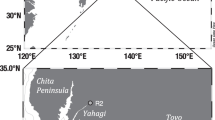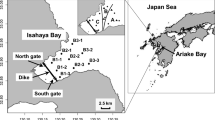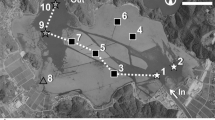Abstract
The spring freshet increases density stratification in Chesapeake Bay and minimizes oxygen transfer from the surface to the deep layer so that waters below 10 m depth experiece oxygen depletion which may lead to anoxia during June to September. Respiration in the water of the deep layer is the major factor contributing to oxygen depletion. Benthic respiration seems secondary. Organic matter from the previous year which has settled into the deep layer during winter provides most of the oxygen demand but some new production in the surface layer may sink and thus supplement the organic matter accumulated in the deep layer.
Similar content being viewed by others
Literature Cited
Barnes, C. A., and E. E. Collias. 1958. Some considerations of oxygen utilization rates in Puget Sound. J. Mar. Res. 17:68–80.
Boicourt, W. C. 1969. A numerical model of the salinity distribution in Upper Chesapeake Bay. Master’s Essay. Johns Hopkins University. 59 p.
Carpenter, J. H. 1965. The Chesapeake Bay Institute technique for the Winkler dissolved oxygen method. Limnol. Oceanogr. 10:141–143.
Carpenter, J. H., and D. G. Cargo. 1957. Oxygen requirement and mortality of the blue crab in the Chesapeake Bay. Ches. Bay Inst. Tech. Rept. No. 13.
Christensen, J. P., and T. T. Packard. 1976. Oxygen utilization and plankton metabolism in a Washington fjord. Estuarine Coastal Mar. Sci. 4:339–347.
Cronin, W. B., and D. W. Pritchard. 1975. Additional statistics on the dimensions of the Chesapeake Bay and its tributaries; Cross section widths and segment volumes per meter depth. Ches. Bay Inst. Spec. Rept. No. 42.
Elliott, A. J. 1976. A numerical model of the internal circulation in a branching tidal estuary. Ches. Bay Inst. Spec. Rept. No. 54.
Gordon, D. C., and W. H. Sutcliffe. 1973. A new dry combustion method for the simultaneous determination of total organic carbon and nitrogen in seawater. Mar. Chem. 1:231–244.
Hårgrave, B. T. 1969. Similarity of oxygen uptake by benthic communities. Limnol. Oceanogr. 14:801–805.
— 1972. A comparison of sediment oxygen uptake, hypolimnetic oxygen deficit and primary production in Lake Esrom, Denmark. Verh. Internat. Verein. Limnol. 18:134–139.
Hartwig, E. O., and J. A. Michael. 1978. A sensitive Winkler Titrator for respiration measurements. Envir. Sci. Tech. 12:712–715.
Hobbie, J. E., B. J. Copeland, and W. G. Harrison. 1972. Nutrients in the Pamlico River Estuary, N.C. 1969–1971. Water Resources Research Institute, Univ. N.C. Rept. No. 76.
IDOE. 1976. Anoxia on the middle Atlantic Shelf during the summer of 1976. Report of NSF Workshop on October 15–16, 1976, in Washington, D.C.
Johnson, M. W., and T. G. Thompson. 1929. The sea water at the Puget Sound Biological Station from September 1927 to September 1928. Pub. Puget Sound Biol. Sta. 7:119–128.
McCarthy, J. J., W. R. Taylor, and M. E. Loftus. 1974. Significance of nannoplankton in the Chesapeake Bay estuary and problems associated with the measurement of nannoplankton productivity. Mar. Biol. 24:7–16.
Newcombe, C. L., and W. A. Horne. 1938. Oxygen-poor waters of the Chesapeake Bay. Science 88:80–81.
Pamatmat, M. M. 1971. Oxygen consumption by the seabed. VI. Seasonal cycle of chemical oxidation and respiration in Puget Sound. Int. Revue Ges. Hydro. Biol. 56:769–793.
Pritchard, D. W. 1968. Chemical and physical oceanography of the Bay. In: Proceedings of the Governors Conference on Chesapeake Bay. 11–13 Sept., 1968. Session IV. p. 49–74. Wye Institute, Wye, Maryland.
Richards, F. A. 1965. Anoxic basins and fjords, p. 611–645. In: J. P. Riley and G. Skirrow (eds.), Chemical Oceanography, Academic Press, N.Y.
Rowe, G. T., C. H. Clifford, K. L. Smith, and P. L. Hamilton. 1975. Benthic nutrient regeneration and its coupling to primary productivity in coastal waters. Nature 255:215–217.
Schiemer, E. W., and D. W. Pritchard. 1961. An induction conductivity indicator. Ches. Bay Inst. Tech. Rept. No. 25.
Schubel, J. R. 1972. The physical and chemical conditions of Chesapeake Bay. J. Wash. Acad. Sci. 62:56–87.
Seki, H., T. Tsuji, and A. Hattori. 1974. Effect of zooplankton grazing on the formation of the anoxic layer in Tokyo Bay. Estuarine Coastal Mar. Sci. 2:145–151.
Smith, K. L. 1974. Oxygen demands of San Diego trough sediments: An in situ study. Limnol. Oceanogr. 19:939–944.
Strickland, J. D. H., and T. R. Parsons. 1972. A practical handbook of sea water analysis. 2nd ed. Bull. Fish. Res. Board Can. 167.
Taft, J. L., and W. R. Taylor. 1976a. Phosphorus distribution in the Chesapeake Bay. Chesapeake Sci. 17:67–73.
—, And-—. 1976b. Phosphorus dynamics in some coastal plain estuaries. In: M. Wiley (ed.), Estuarine Processes. Vol. 1. Academic Press, New York.
Taylor, W. R., and W. B. Cronin. 1974. Station data, AESOP cruises. April 1969 to April 1971. Ches. Bay Inst. Special Report 38. 228 p.
Venrick, E. L., J. R. Beers, and J. F. Heinbokel. 1977. Possible consequences of containing microplankton for physiological rate measurements. J. Exp. Mar. Biol. Ecol. 26:57–76.
Wang, D. P., and D. W. Kravits. 1980. A semi-implicit two-dimensional model of estuarine circulation. J. Phys. Oceanogr. 10:441–454.
Whaley, R. C., J. H. Carpenter, and R. L. Baker. 1966. Nutrient data summary 1964, 1965, 1966: Upper Chesapeake Bay (Smith Point to Turkey Point), Potomac, South, Severn, Magothy, Back, Chester, and Miles rivers; and Eastern Bay. Ches. Bay Inst. Spec. Rept. 12.
Author information
Authors and Affiliations
Rights and permissions
About this article
Cite this article
Taft, J.L., Taylor, W.R., Hartwig, E.O. et al. Seasonal oxygen depletion in Chesapeake Bay. Estuaries 3, 242–247 (1980). https://doi.org/10.2307/1352079
Issue Date:
DOI: https://doi.org/10.2307/1352079




